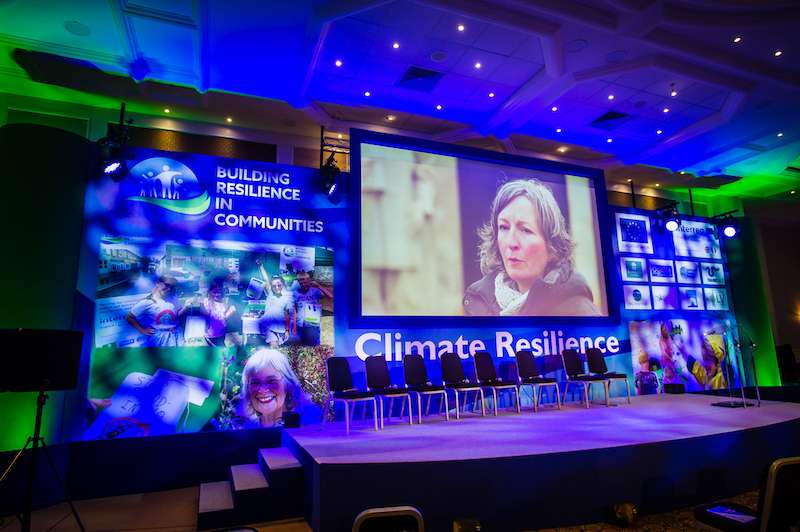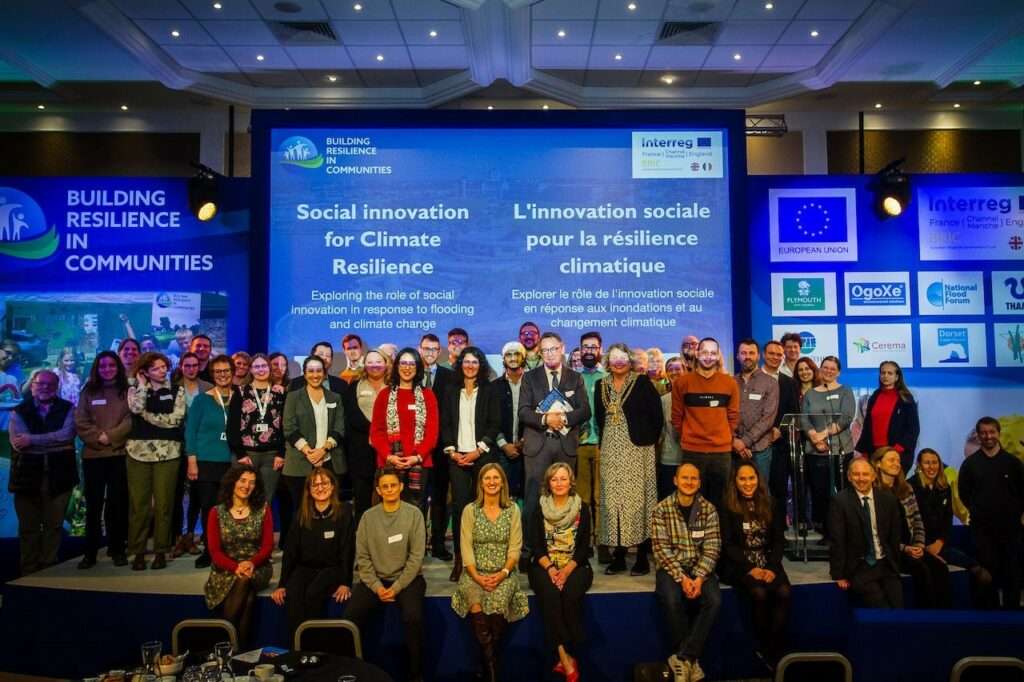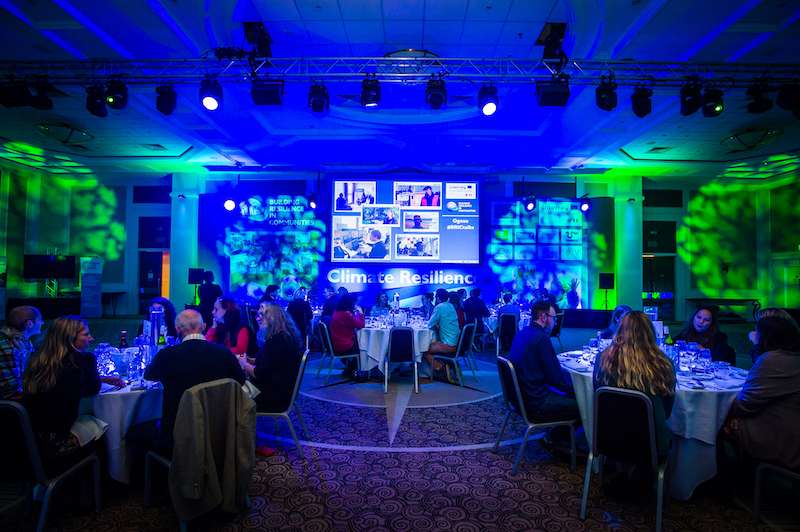The BRIC Project
The Interreg funded Building Resilience in Communities (BRIC) project has been a two-year cross-channel social innovation project running until June 2023. The project was a collaboration between eight organisations in France and England. The project’s key aim was to build resilience in local communities who are at risk of flooding using innovative engagement methods and new technologies.
An Introduction to the Seminar
The BRIC Project’s final event, the Social Innovation for Climate Resilience Seminar, took place at the Crowne Plaza Hotel in Plymouth on the 15th March 2023. Over 100 people both in person and online from France and England attended the event. English and French simultaneous translation was available throughout.

The host, Justin Leigh, warmed up the stage and introduced the morning session by welcoming the Lord Mayor of Plymouth, Cllr Sue Dann, to the stage. Cllr Dann formally welcomed seminar attendees to Plymouth and opened the seminar.


Liza Oxford, the BRIC Project Lead then took to the stage to introduce the BRIC Project and the BRIC Resilience Model Guidehttps://platform.bric-network.com/platform/p/43/bric-model-guide, created as one of the final outputs the project. The BRIC model guide is a user manual to help build resilience in communities; Liza encouraged participants to write their notes from the day in the guide as it was created to be a living document.

Social Innovation Tools
The next stage of the seminar was dedicated to the social innovation tools developed and tested during the project, and representatives from each project partner presented on the tools that they led on.
Liza Oxford and Sarah Durbridge from Plymouth City Council, presented on Appreciative Inquiry (AI) as a model for initial engagement, and diagnostic and behaviour change, sharing data collected from the Plymouth pilot site.

Céline Fontaine from CPIE, presented on various one-off interventions they carried out with their communities, particularly focusing on the benefits of a month-long highlight, the Festival of Resilience in Vallée de l’Autie.

David Jordan from the National Flood Forum (NFF) presented on working with Flood Action Groups and the community-led mapping pilot to map local flood risk assets, issues and concerns in Kent.

Imane Fedaili from Oise-les-Vallées, discussed two awareness-raising activities: awareness-raising workshops for schoolchildren, and an educational walk for the elderly.

Dan Williams from the Dorset Coastal Forum (DCF) presented the creation of the local householder’s guide to flood resilience covering the design process, the benefits and challenges of co-production, and the lessons learnt during its creation in Weymouth.

Céline Perherin from Cerema discussed the co-construction of community events around the river Aulne, culminating in a weekend festival focused on the Aulne river and its issues.

Chris Coode and Lucy Jackson from Thames21 presented on their innovative techniques for community engagement on Canvey Island, including PhotoVoice workshops and an exhibition and SuDs mapping activities.

Aileen Robert, Hugues Tavernier and Boris Legemble from OgoXe delivered the public launch of the Resilience Networks via the BRIC Web Platform.

This session was followed by a Q&A session with a panel made up of the presenters. The panel were asked about the community engagement techniques that had been implemented through the course of the project, how to reach target audiences and key influencers, and what each of the panel would do if the project were to continue for another 2 years.
“Appreciative Inquiry gave us the opportunity to approach our communities in a different way to what we might do normally, like public consultations, or notices just stuck on a telegraph pole. It gave us the opportunity to talk to our communities on their level.”
– Liza Oxford, PCC
“Two years is far to short for a project of this scale. We would love to be able to continue supporting the flood warden group. We have got the group self-sustaining, but now we are leaving.”
– Dan Williams, DCF
“We would like to replicate what we have done in just one small area in another one, in different catchments.”
– Celine Fontaine, CPIE

Keynote Speakers
Dusty Gedge, President of the European Federation of Green Roof and Wall Associations, gave a fascinating speech about the use of green roofs and walls, and his experiences of implementing them across the UK and Europe. These are outstanding examples of innovative techniques to work towards climate resilience, and particularly relevant were the examples of green infrastructure used to store water, thereby reducing the risk of flooding.

Samuel Rufat joined onlinefrom the European Commission on Resilience and Social Vulnerability, and posed some very interesting ethical questions in his presentation, which provoked some deep thinking and discussion. How do we prioritise who should be helped first? What do we even mean by ‘vulnerable’ or ‘resilient’? The data showed that most people believed that the most vulnerable in society, i.e. those with health or medical conditions, should be prioritised, over and above those that is may be easier to work with.

Hannah Baker, Programme Manager at Communities Prepared UK, spoke about the work they do in training communities to become more resilient to flooding, through flood warden training and community emergency volunteer training. Parallels can be drawn between the BRIC Project’s work in developing training modules for communities, as well as the work completed in the Weymouth pilot site, where a flood warden resilience network has been created.

Ghislaine Verrhiest-Leblanc, Director General of the French Association for the Prevention of Natural and Technological Catastrophes, spoke about the culture of risk. Many factors can influence how people respond to risk, including memories of past experiences, which can result in people who do not have lived experience of a disaster or other situation, particularly younger people, underestimating their risk, and therefore becoming more vulnerable.


Beyond BRIC: The Next Steps
Andy Sharp, Head of Business Improvement at Plymouth City Council, presented on what the future holds beyond the end of the BRIC project. Talking specifically about Plymouth, he discussed some of the impacts that learnings from the BRIC project have already had on council policy going forwards, where they will have more of a focus on climate resilience. This includes adjusting drain clearing maintenance schedules, road sweeping and watercourse management policy. New funding opportunities for green infrastructure, Sustainable Drainage Systems (SuDS) and nature-based solutions are being explored and implemented. Plymouth City Council will also be building on their achievements during the BRIC project by participating in a new project, Devon Resilience Innovation Project (DRIP), a Flood and Coastal Resilience Innovation Project alongside partners across Devon. This will allow the knowledge and experience gained through BRIC to be shared more widely for the benefit of more communities.

Sebastien Dupray, Director of the Technical Division of Cerema’s Water and Sea Risks, recalled that almost 20 million people are at risk from flooding in France. Despite the prevention policies implemented at a local and national level, only 24% of people exposed to flooding consider themselves to be at risk. A national action plan, Tous resilients face aux Risques, has been created for 2021. As part of this plan, Cerema is supporting local authorities and decentralised government departments to implement measures to raise awareness and get people involved. In particular, through the publication of guides guides https://www.cerema.fr/en/centre-ressources/boutique/risk-culture.

Conclusions
BRIC has enabled the development of a platform to raise flood awareness amongst communities, using social innovation tools. Communities can feel empowered to take action for their own resilience through various means such as:
- Participating in a community-led mapping project
- Creating an emergency plan based on information in a householder guide to flooding.
- Partaking in events and festivals aimed at different target audiences ensure that nobody is excluded from the opportunity to learn more about their own flood risk and the steps they can take to build resilience.
- Distributing Householder Guides and newsletters to reach wider audiences.
- Communicate in flood resilience networks via the BRIC web platform through surveys
- Improve their knowledge and understanding of resilience through training modules.
The above innovations can be built upon going forwards using the BRIC Model Guidehttps://platform.bric-network.com/platform/p/43/bric-model-guide that creates a long-lasting legacy for the BRIC project.
Two years for such an intense and important project was always going to be a major challenge, however the partnership is proud of their achievements over such a short time. The tools created and tested during the course of the project have paved the way for further building the resilience of communities in the future.

